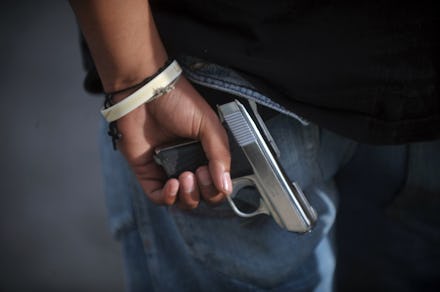A New Study Shows the Frightening Impact of Bullying on Young People

January was not a good month for America's schools. In the span of 19 days, there were 11 different school shootings — not counting the four close calls that did not result in any injuries.
Any time such a tragic incident happens, people immediately try to find the answer: Why did this happen? How could such a terrible thing happen?
Though it could often be an empty exercise to try to figure out what pushes a young student to an act of violence, a new study is shedding some light on the issue. Researchers at the Cohen Children's Medical Center of New York crunched data from the 2011 Youth Risk Behavior Surveillance System from the Centers of Disease Control and Prevention, and they found a highly probable reason why many students bring a weapon to school: bullying.
The study found that in an average 30-day span, around 200,000 high school students who were bullied brought a weapon to school; that is a significant portion of the 750,000 students who are estimated to come armed to class every month. And the likelihood increased with the severity of victimization. "Victims of bullying who have been threatened, engaged in a fight, injured, or had property stolen or damaged are much more likely to carry a gun or knife to school," said senior investigator Andrew Adesman.
Image Credit: Mother Jones
What does this mean? As Vox's German Lopez points out, correlation does not necessarily mean causation. Around 20% of students who participated in the study reported being bullied, but it's not as though one in every five students brings a weapon to school. It could very well be that students who brought weapons were bullied for their antagonistic behavior, or had easy access to guns or an unrelated history of mental illness.
And it's a dangerous instinct to try to boil a complex issue like school violence to a single cause. "We all want to find a simple motivation when children go to school intending to do harm, but the problem in blaming school shootings on 'bullying' is that it lets us off the hook too easily, so that we don’t have to deal with the more difficult issues of parental involvement, mental health, media images, the Second Amendment," wrote the Washington Post's Maria De La O last October.
But the numbers don't lie either. As the Department of Health and Human Services' StopBullying.gov website points out, "In 12 of 15 school shooting cases in the 1990s, the shooters had a history of being bullied." And a U.K. study last month revealed that students who were bullied from an early age had lasting damage — physically and mentally.
So while bullying cannot be seen as the definitive cause behind guns in schools, one cannot completely discount it either. These numbers show precisely why bullying prevention and intervention are so crucial.